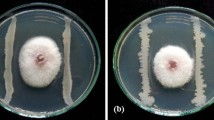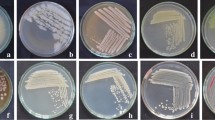Abstract
Plant growth promoting Bacillus subtilis MSS9 and Bacillus licheniformis MSS14 were isolated from the tomato rhizosphere. These isolates were capable of inhibiting the fungal pathogen, Fusarium oxysporum f. sp. lycopersici causing fusarium wilt in tomato, tested by dual culture method and by mycolytic enzyme production. The isolates have the capacity to form biofilm on the microtitre plate. Scanning electron microscopy revealed good colonization capacity of Bacillus licheniformis MSS14 on tomato plant root as compared to Bacillus subtilis MSS9, pot experiments were also analyzed to study the effects of both rhizobacterial cultures on pathogen development and plant growth. It was observed that MSS14 reduces the incidence of Fusarium oxysporum f. sp. lycopersici in tomato and there was significant increase in vegetative parameters like root length, shoot length, plant wet weight, dry weight and chlorophyll content after which indicates that the root colonization property of the culture MSS14 helps in enhancing the biocontrol capacity against pathogen than that of MSS9.





Similar content being viewed by others
References
Abdul-Baki, A., & Anderson, J. D. (1973). Vigor determination in soybean seed by multiple criteria. Crop Science, 13, 630–633.
Anjaiah, V., Cornelis, P., & Koedam, N. (2003). Effect of genotype and root colonization in biological control of fusarium wilts in pigeonpea and chickpea by Pseudomonas aeruginosa PNA1. Canadian Journal of Microbiology, 49, 85–91.
Berg, G., Krechel, A., Ditz, M., Sikora, R. A., Ulrich, A., & Hallmann, J. (2005). Endophytic and ectophytic potato- associated bacterial communities differ in structure and antagonistic function against plant pathogenic fungi. FEMS Microbiology Ecology, 51, 215–229.
Bolwerk, A., Lagopodi, A. L., Wijfjes, A. H., Lamers, G. E., Chin, A. W. T. F., Lugtenberg, B. J., & Bloemberg, G. V. (2003). Interactions in the tomato rhizosphere of two Pseudomonas biocontrol strains with the phytopathogenic fungus Fusarium oxysporum f. sp. radicis-lycopersici. Molecular Plant-Microbe Interactions, 16, 983–993.
Chaiharn, M., Chunhaleuchanon, S., & Lumyong, S. (2009). Screening of siderophore producing bacteria as potential biological control agent for fungal rice pathogen in Thailand. World Journal of Microbiology and Biotechnology, 25, 1919–1928.
Compant, S., Reiter, B., Sessitsch, A., Nowak, J., Clement, C., & Barka, E. A. (2005). Endophytic colonization of Vitisvinifera L. by a plant growth-promoting bacterium, Burkholderia sp. strain PsJN. Applied and Environmental Microbiology, 71, 1685–1693.
Davey, M. E., & O’Toole, G. A. (2000). Microbial biofilms: from ecology to molecular genetics. Microbiology and Molecular Biology Reviews, 64, 847–867.
Friedman, L., & Kolter, R. (2004). Genes involved in matrix formation in Pseudomonas aeruginosa PA14 biofilms. Molecular Microbiology, 51, 675–690.
Haggag, W. M., & Timmusk, S. (2008). Colonization of peanut roots by biofilm- forming Paenibacillus Polymyxa initiates biocontrol against crown rot disease. Journal of Applied Microbiology, 104, 961–969.
Jha, C. K., & Saraf, M. (2011). Invitro evaluation of indigeneous plant growth promoting rhizobacteria isolated from Jatropha curcas rhizosphere. International Journal of Genetic Engineering and Biotechnology, 2(1), 91–100.
Karimi, K., Amini, J., Harighi, B., & Bahramnejad, B. (2012). Evaluation of biocontrol potential of Pseudomonas and Bacillus spp. against Fusarium wilt of chickpea. Australian Journal of Crop Science, 6, 695–703.
Kloepper, J. W., & Schroth, M. N. (1981). Relationship of in vitro antibiosis of plant growth promoting rhizobacteria to plant growth and displacement of root microflora. Phytopathology, 71, 1020–1024.
Kouki, S., Saidi, N., Rajeb, A. N., Brahmi, N., Bellica, A., Fumio, M., Hefiene, A., Jedidi, N., Downer, J., & Ouzari H (2012). Control of Fusarium wilt on tomato caused by Fusarium oxysporum f. sp. Radicis-Lycopersici using mixture of vegetable and Posidonia oceanica compost. Applied and Environmental Soil Science, doi:10.1155/2012/239639
Latour, X., Corberand, T., Laguerre, G., Allard, F., & Lemanceay, P. (1996). The composition of fluorescent pseudomonad population associated with roots is influenced by plant and soil type. Applied and Environmental Microbiology, 62, 2449–2456.
Lugtenberg Ben, J. J., Dekkers, L., & Bloemberg, G. V. (2001). Molecular determinants of rhizosphere colonization by Pseudomonas. Annual Review of Phytopathology, 39, 46–90.
Markovich, N. A., & Kononova, G. L. (2003). Lytic enzymes of Trichoderma and their role in plant defense from fungal diseases: a review. Applied Biochemistry and Microbiology, 39(4), 341–351.
Morris, C. E., & Monier, J. M. (2003). The ecological significance of biofilm formation by plant-associated bacteria. Annual Review of Phytopathology, 41, 429–453.
O’Toole, G. A. (2011). Microtiter dish biofilm formation assay, JOVE.47, http://www.jove.com., doi:10.3791/2437
O’Toole, G., Kaplan, H. B., & Kolter, R. (2000). Biofilm formation as microbial development. Annual Review of Microbiology, 54, 49–79.
Raaijmakers, J. M., Leeman, M., van Oorschot, M. M. P., van der Siuls, I., Schippers, B., & Bakker, P. A. H. M. (1995). Dose-response relationships of biological control of fusarium wilt of radish by Pseudomonas spp. Phytopathology, 85, 1075–1081.
Roomberg, M. K., & Davis, R. M. (2007). Host range and phylogeny of Fusarium solani f.sp. eumartii from potato and tomato in California. Plant Disease, 91, 585–592.
Sambrook, J., Fritsch, F. E., & Maniatis, T. A. (1989). Molecular cloning: a laboratory manual (2nd ed.). Cold Spring Harbor: Cold Spring Harbor Laboratory Press.
Selvakumar, G., Reetha, R., & Thamizhiniyan, P. (2013). The PGPR elicitors of plant defense mechanisms and growth stimulants on tomato (Lycopersicum esculentum Mill.) Botany Research International, 6, 47–55.
Singha, I. M., Kakoty, Y., Unni, B. G., Kalita, M. C., Das, J., Naglot, A., Wann, S. B., & Singh, L. (2011). Control of Fusarium wilt of tomato caused by Fusarium oxysporum f. sp. Radicis-Lycopersici using leaf extract of Piper betle L.: a preliminary study. World Journal of Microbiology and Biotechnology. doi:10.1007/s11274–011–0730-6.
Smyth, D. R., Bowman, J. L., & Meyerowitz, E. M. (1990). Early flower development in Arabidopsis. Plant Cell, 2, 755–767.
Tamura, K., Dudley, J., Nei, M., & Kumar, S. (2007). MEGA4: molecular evolutionary genetics analysis (MEGA) software version 4.0. Molecular Biology and Evolution, 24, 1596–1599.
Tank, N., & Saraf, M. (2008). Enhancement of plant growth and decontamination of nickel spiked soil using PGPR. Journal of Basic Microbiology, 49(2), 195–204.
Acknowledgements
We are thankful to Department of Microbiology and Biotechnology, Gujarat University to encourage and help us with the required facility and work and British Petroleum International Pvt. Ltd. for financial support.
Author information
Authors and Affiliations
Corresponding author
Rights and permissions
About this article
Cite this article
Patel, S., Saraf, M. Interaction of root colonizing biocontrol agents demonstrates the antagonistic effect against Fusarium oxysporum f. sp. lycopersici on tomato. Eur J Plant Pathol 149, 425–433 (2017). https://doi.org/10.1007/s10658-017-1192-y
Accepted:
Published:
Issue Date:
DOI: https://doi.org/10.1007/s10658-017-1192-y




